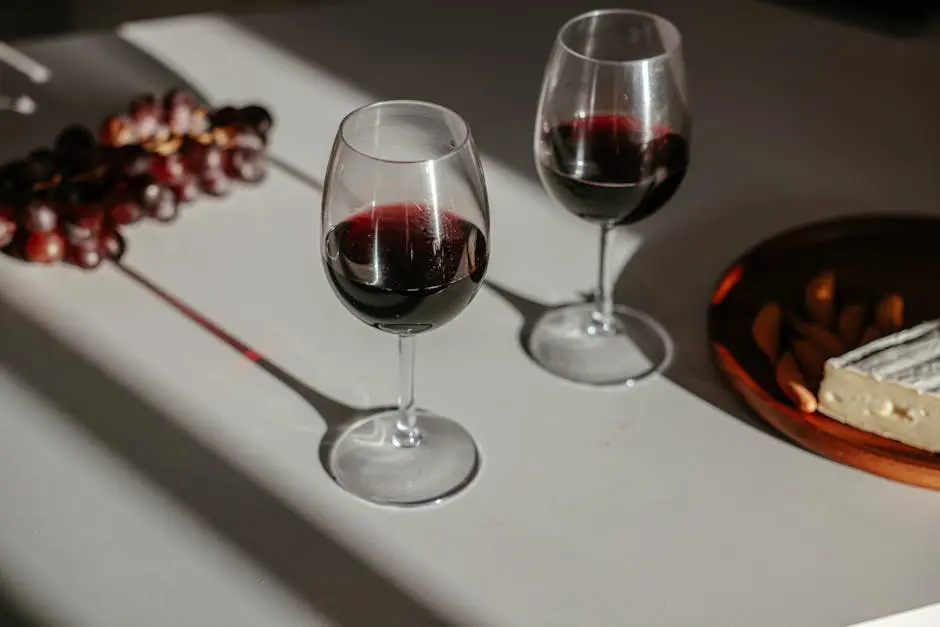Wine pairing can transform an ordinary meal into a delightful experience. Whether you’re a seasoned connoisseur or a curious newbie, understanding the art of pairing wine with food can elevate your dining moments. Dive into these fun facts about wine pairings that promise to enhance your drinks delight.
1. White Wines and Light Foods
A classic rule is to match white wines with light foods. Think of crisp Sauvignon Blanc paired with a fresh salad or delicate seafood dish for an experience that feels like a summer breeze. This pairing is all about balance, as the zesty notes of the white wine work in harmony with the freshness of the dish. Such combinations highlight the nuances in flavors, making each dining experience a journey of its own. For example, pairing a Sauvignon Blanc with goat cheese creates a zingy flavor profile that delights the senses. Similarly, pairing Chardonnay with buttery lobster amplifies the luxurious texture and richness of the dish.
But the world of white wine pairing extends beyond these staples. Take the lively Riesling, for instance, whose bright acidity pairs exquisitely with spicy Asian or Indian dishes. The high acidity in the wine offers a refreshing contrast, cutting through the spice and providing a refreshing sip. This not only enhances the taste of the dish but also elevates your overall dining experience. Light salads with citrus vinaigrettes also pair well with sparkling whites, accentuating the citrusy notes for a more vibrant taste.
2. Red Wines with Rich Flavors
Rich reds like Cabernet Sauvignon or Merlot complement hearty dishes such as steak or roast lamb. The bold flavors enhance each other, creating a robust drinks delight. These wines provide the perfect accompaniment to meals requiring robust flavor profiles. A Merlot’s soft tannins and fruit-forward profile balance the rich gaminess of lamb, while a Cabernet’s high tannin content pairs exceptionally well with the succulence of a grilled prime rib. Uncover the art of pairing wine that elevates dining to an exquisite experience.
3. Discovering Rosé Versatility
Rosé wines offer exceptional versatility, easily pairing with a wide range of foods. From barbecue to spicy cuisine, a chilled glass of rosé brings a refreshing balance. This wine’s versatility stems from its position between the structure of red wines and the lightness of whites. This dual nature allows rosé to complement anything from grilled prawns to a charcuterie board. Pair it with summer salads dressed with berry vinaigrettes to enhance the fruitiness in both the wine and meal. The possibilities are endless, and when exploring new foods with rosé, creativity is your best ally.
4. Sweet Wine and Spicy Cuisine
Sweet wines like Riesling or Moscato can tame the heat of spicy dishes. The sweetness offers a contrasting yet delightful pairing with spicy Asian or Latin foods. This contrast transforms the dining experience, cooling the heat with every sip. For instance, a spicy Thai curry can come to life with the addition of a semi-sweet wine that not only complements the spice but also magnifies the intricate flavors within the dish. Likewise, dishes featuring chili peppers or Sichuan spices find a lovely companion in a slightly sweet wine.
Beyond the typical pairings, sweet wines also excel with spicy desserts, like chocolate chili mousse. The chocolate’s richness and the chili’s spice are balanced by the wine’s sweetness, creating a layered experience for the palate.
5. Acidic Wines Complement Fatty Meals
Wines with high acidity, such as Chianti, can cut through rich, fatty dishes. They refresh the palate, making every bite of a creamy pasta or rich stew newly flavorful. The magic of this pairing lies in the way acidity acts much like a squeeze of lemon might, adding brightness and reducing the heaviness of a dish. Picture a Chianti with a decadent lasagna or burrata, allowing every nuanced flavor to shine. Additionally, Sauvignon Blanc’s acidity can slice through fried dishes, making it an unexpected yet delightful companion to fish and chips.
6. Sparkling Wines for Celebrations
Nothing says celebration like a glass of bubbles. Sparkling wines like Champagne or Prosecco pair well with salty snacks, seafood, and even fried foods, adding a fizzy delight to your meal. The effervescence of sparkling wines contrasts beautifully with the richness of the foods, cleansing the palate and preparing it for the next bite. Imagine a bottle of bubbly with a dish of oysters or a serving of truffle fries—it’s a sensory experience of textures and tastes, highlighted by the wine’s vivacious bubbles. At events that stand out, like weddings or festive parties, nothing enhances the ambiance quite like sparkling wines.
7. Dessert Wines and Sweet Matches
Dessert wines are made to shine with sweets. Pair a glass of Port with chocolate desserts or try a Sauternes with fruit-based dishes for a heavenly end to any meal. These wines are crafted to match the sweetness of the desserts, ensuring that one does not overwhelm the other—creating a harmony that’s perfect for indulgence. A late-harvest Muscat paired with a citrus tart brightens the sweetness while offering a compelling depth, fulfilling many flavor profiles. Understanding such pairings can transform an ordinary dessert course into an unforgettable finale.
8. Finding Umami in Wine Pairings
Umami-rich foods, like mushrooms or aged cheese, find a wonderful partner in wines like Pinot Noir or Sherry, each sip highlighting the savory notes beautifully. These wines’ earthy undertones create a resonance with umami flavors, making dishes like mushroom risotto or a selection of strong cheeses an even greater delight. As you explore this pairing, note how the savory essence of the food complements the wine’s complexity, creating a layered tapestry of taste. This depth of flavor arises from the amino acids in umami foods that enhance the wine’s structure, delivering mutual amplification.
9. Experimenting with Earthy Wines
Earthy wines like Syrah can echo the flavors of root vegetables and foods cooked with herbs. Explore these combinations to unveil earthy delight in every bite. When tasted alongside roasted beets, wild mushrooms, or dishes with a thyme or rosemary infusion, the earthy notes of the wine meld with the dish’s inherent flavors. These pairings invite an exploration beyond the traditional, appealing to those keen on experiencing the depth and complexity of such tastes. This journey into earthy pairings enriches the dining table, transforming a meal into a curated experience of discovery and enjoyment.
10. Tannin Impact on Meat Dishes
Tannic wines, such as Malbec, soften with protein, creating a smoother texture. Pair these robust wines with grilled meats to enhance your drinks delight manifold. Tannins bring structure to a wine, often making bold reds an excellent match for meats like brisket and venison. The tannins bind with proteins in the meat, muting their astringency and heightening the flavors, offering a richer, smoother taste experience. This interaction is why commanding red wines like Malbec or Nebbiolo find their ideal companions in prime cuts of beef or lamb, making each bite a celebratory offering.
11. Considering Wine Temperature
Serving wine at the correct temperature impacts flavor and pairing success. Reds at room temperature, whites chilled, and sparklings well-cooled are guidelines to follow. The right temperature can amplify the wine’s characteristics—chilling whites enhances their crispness, while reds at room temperature maintain their richness. Sparkling wines require a cooler serving to retain their effervescence. Understanding these guidelines can make every pour more delightful, encouraging you to experiment and find the perfect temperature that aligns with your taste. It’s these details that convert a routine meal into a refined dining experience.
12. Creating Balance with Wine and Cuisine
Balance is key in pairing. A well-paired wine should neither overpower nor be overshadowed by the dish it accompanies. Finding harmony is the essence of a perfect pairing. The interplay of wine and cuisine is an art, aiming for equilibrium where both elements shine. This can be observed when a light Pinot Grigio complements a seafood dish without eclipsing its delicate flavors. Conversely, a well-bodied Shiraz should bolster a robustly flavored dish without dominating its major notes. Achieving this balance allows diners to appreciate each aspect independently while experiencing them in unified harmony.
Mastering this balance involves understanding flavor intensities and ensuring no single component overwhelms. When wine and dish beautifully correlate, their flavors intermingle, celebrating each course as more than just nutrition—transforming it into a holistic experience.
13. Regional Pairing Practices
Many pairing traditions involve regional matches. Consider enjoying Italian wines like Chianti with Italian cuisine to experience time-honored pairing principles. This idea of terroir, where food and wine originating from the same place naturally complement each other, offers unique perspectives on pairing methods. A rich Chianti brings out the vibrant flavors of a Tuscan pasta dish, just as a regionally matched Sauvignon Blanc with French goat cheese showcases the heart of Loire Valley traditions. These regional pairings not only celebrate cultural heritage but also invite you to explore the authenticity of flavors shaped by climate and geography.
Venturing into these regional customs allows you to appreciate how historical context influences our taste preferences and pairing decisions. It crafts a deeper understanding of the synergy between a region’s vinicultural practices and its culinary delights.
14. Breaking the Rules with Wine Pairing
While traditional rules guide pairings, wine is also about personal enjoyment. Feel free to break the norms and discover what enlivens your palate for a unique drinks delight. Experimentation can lead to surprising discoveries, such as enjoying a Cabernet Sauvignon with a chocolate dessert or pairing a chilled white wine with a steak. Such combinations may deviate from convention but can offer exceptional taste experiences tailored to personal preferences. Ultimately, the beauty of wine lies in its versatility, inviting enthusiasts to curate their journey through diverse and daring pairings.



